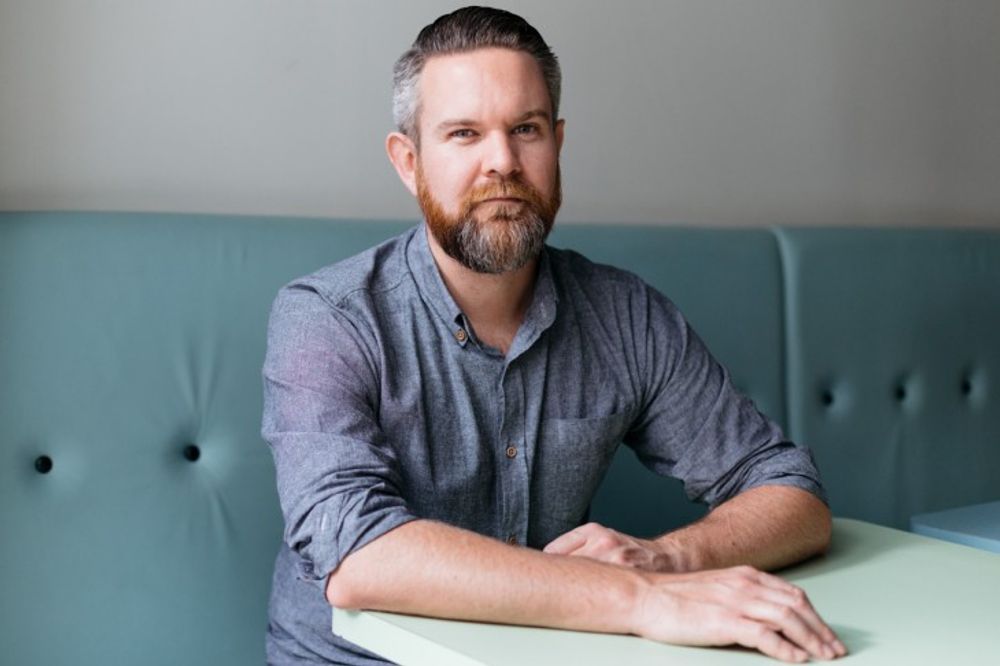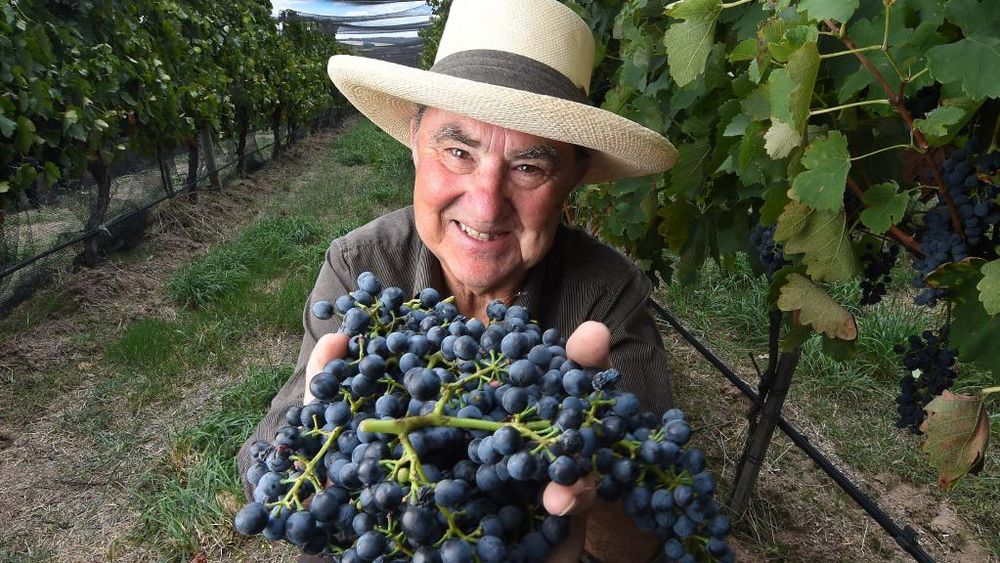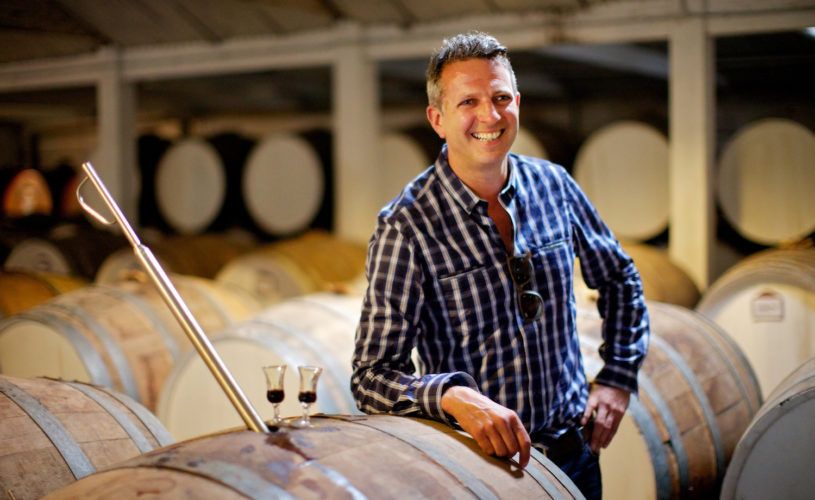In his first article Tim Wildman MW shone the light on the changes taking place in viticulture, journalismand Chardonnay in Australia. He now looks at consumer events, the influence of Adelaide Hills’ Basket Range region and natural wines.
Tim Wildman MW should know a thing a two about where the Australian wine industry is going. Born and bred in the UK he is slowly making Australia is home with his two new professional careers: first as founder and organiser of the James Busby Travel wine business which gives wine professionals around the world the chance to dig deep and discover the changing face of Australian wine for themselves.
And secondly as a winemaker in his own right, having proudly just sold out in the UK of the first vintage of his Pet Nat wine made in South Australia under the brilliant Astro Bunny and Dark Side labels. Or as he puts it: “I use Vermintio, Nero d’Avola and Zibbido. The wines have no added sulphur, no adds and no adjustments. Just fermented grape juice with now take out. Made from grapes.”
The first part of his two parter in to the six most disruptive wine trends in Australia was one of the biggest read and shared articles published on The Buyer. So here we go with part two and his fourth, fifth and sixth most disruptive trends.
4. Consumer events

Aussie wine tasting Game of Rhones style with Bottle Shop Concepts
When you land on the homepage of Bottle Shop Concepts website the headline that greets you is “WE TAKE THE WANK OUT OF WINE”. Their flagship event is called Pinot Palooza (think PinotFest for consumers), their most recent event is Meat Your Maker (a celebration of artisan and ethical food) and my personal favourite is Game of Rhones, where winemakers dress in Medieval Fantasy costumes pouring red and white Rhone blends.
The ringmaster behind all of this theatrical vinous fun is Dan Sims, sommelier turned consumer events innovator. I asked Dan to explain the philosophy behind what he does.

Dan Sims: the creative force behind Bottle Shop Concepts and its left field tastings
“I don’t see us being in the wine business, or events business to be honest, we’re in the hospitality business; that is my background after all. In all my years as a sommelier I never sold a wine on facts and figures, it was on style and story because people connect to people, not stainless steel tanks and malolactic fermentations. It makes you put the customer first.
“As a sommelier, you have 30 seconds to a minute in front of someone to figure out what they like, within their price point and match it their food. For me that training is the core of what we do. And essentially it’s fun first, facts second. That’s not to say facts aren’t important, they are, but give them when asked, don’t assume. Why not start with ‘hello’?
“Never before have people been more interested in what they imbibe. But they want to learn about it the same way they consume it; socially. They don’t want to learn about it sitting in a classroom listening to a bunch of men (generally old) telling them what they don’t know.
“The default setting for most of the wine industry is ‘teacher vs student’. ‘We’ know all about wine and MUST educate the wine drinker to death then complain that they just don’t care enough about our vinous product. We prefer to make it more ‘peer to peer’ and if you look at every industry out there, that is what it’s all about.
“I’d like to think we don’t have bad wine at our events. Sure, people will prefer one over the other but it comes down to a question of style. And all we ask them to do it pick their favourite. That’s it. Also, we narrow the bandwidth with our event focusing on one variety (Pinot or Malbec) or styles (Rhones). That helps focus attention rather than the normal ‘scatter gun’ approach of styles and varieties where there is so much to take in with little really sticking (in 30 second interactions).
“People are super pumped for wine but they don’t want to be bored to death. I get if some people in wine look at what we do and laugh and or not get it, that’s fine. These events are not for them. I can tell you that an awful lot of thought and planning goes into them. We look outside the industry for inspiration and look at how they engage with their consumer.
“Take music. So many different styles and genres. But if you like it you download it, stream it, buy vinyl, go to live gigs, read about it. It’s part of your life. You don’t wake up one morning saying ‘I really like music, I should go to a master class on it’! At the end of the day, it’s all about creating an experience. And that is what people are looking for. An interaction, not a transaction.”
At the end of our email correspondence Dan left me with this final thought: “Too many in the industry forget it’s actually about enjoyment.” This echoes Andrew Jefford’s famous phrase that for most ordinary people wine is associated with hilarity and good times, so why don’t we see that in the way the industry presents itself.
I don’t think the UK has a single consumer wine event that comes close to what Bottle Shop Concepts are doing. After conquering Australia, New Zealand and Asia I’d love to see Dan bring his brand of theatrical consumer events to these shores and sow a little disruptive creativity.
5. The Basket Range
What does disruptive taste like? Could it be a new wine style, a new producer, or even a new community? In just over five years the Basket Range region in the Adelaide Hills has propelled itself to the forefront of Australia’s natural wine movement, with a cluster of innovative, artisan winemakers producing some of the most exciting and delicious wines in the country.
Anton Van Klopper from Lucy Margaux Vineyards was one of the pioneers of the Basket Range, who in turn inspired James Erskine (Jauma Wines) and Gareth Belton (Gentle Folk). The creative energy of these producers has attracted a whole new raft of free spirits in recent years, producers who have chosen to settle in the Basket Range, make their wines and raise their families.
These include Taras and Amber Ochota (Ochota Barrels), Brendan and Kirsty Keys (BK Wines) and Charlotte Hardy (Charlotte Dalton Wines). I asked Taras to send me a few words on what makes Basket Range special.

Taras Ochata is part of a group of cutting edge winemakers in the Adelaide Hills
“What sets it apart from the rest of the Hills and South Australia……the narrow windy dirt roads lined with pine and porcini mushrooms amongst thick forest, spring fed streams lead to steep small land plots populated mostly by long haired creative sorts. Winemakers, vignerons, chefs, potters, painters and musicians. The majority population of young couples turning into families shows there is something in the water. Organics, biodynamics and a wholistic approach to life is rife. It’s only restaurant is a wood oven wine lounge in the local church called ‘lost in a forest’. And only a 20 minutes Kombi ride to the CBD”(that’s Central Business District for non-Australian speakers).
6. The Natural Wine Movement
For those who think that natural wine is a passing fad, or a sideshow, it’s important to understand just how important the movement is – and will continue to be – for Australian wine. The natural wine movement, as small as it may be in terms of volume, is shaking up the entire Australian wine industry, from top to bottom, from big brands to the corporates.

Julien Castagna is one of a number of natural winemakers making their mark
Names to look out for, in addition to the Basket Range producers mentioned above, include Si Vintners (Margaret River), Fall From Grace (McLaren Vale), Harkham Wines (Hunter Valley), William Downie (Gippsland), Avani (Mornington Peninsula), Castagna (Beechworth), Murdoch Hill (Adelaide Hills), Ngeringa (Adelaide Hills), The Other Right Wines (Adelaide Hills), Luke Lambert (Yarra Valley), Patrick Sullivan Wines (Yarra Valley) and Commune of Buttons (Adelaide Hills).
To understand this impact we need to look at some history. When exports of Australian wine fell off a cliff in the early 2000s scapegoats were sought everywhere, from exchange rates, global competition, the ubiquity of critter brands to the global financial crisis.
The elephant in the room was that a lot of Australian wine, even fine wine, simply wasn’t very good. Following Parker’s blessing in the late 90s many Australian wines became over ripe, over extracted, over oaked, over acidified, over manipulated and simply undrinkable.
This stylistic shift has to be seen in an historical context. Much of the expansion of Australia’s vineyards during the boom years of the 90s required not only machine harvesting but also machine pruning and wholly mechanised vineyard practices due to the lack of labour in remote viticultural regions.
Unlike Chile, California and South Africa, Australia doesn’t have a readily available pool of cheap labour to call upon. Australia is also massively inappropriately planted, the baby boomer generation that oversaw the expansion of its vineyards were in awe of France’s classic regions, and varieties were planted according to fashion, with little regard to climate appropriate choices.
Two thirds of Australia is planted to just three grape varieties, Cabernet Sauvignon, Chardonnay and Shiraz. Yet over 90% of Australia’s wine regions are warm to hot climates. Ask yourself which of those three varieties are naturally suited to warm climates, and the answer is only Shiraz, and then at a push. Vignerons in the Northern Rhone wouldn’t consider their climate to be hot.
Fit for purpose
The upshot is that much of Australia’s grape crush is mechanically harvested fruit that is grown in regions too hot to suit it, so grapes come into the winery not only bashed about but with the wrong numbers, acids too low, sugars too high. This requires significant corrective behaviour in the winery. As one winemaker observed to me recently, Australian winemakers are taught to see fruit as a problem that needs to be fixed, and to a man with a hammer everything looks like a nail.
Enter the natural wine movement. Although difficult to define most would agree that those who work within this sensibility look to use climate appropriate varieties, grown with as little chemical inputs as possible in the vineyard and with as few additions or adjustments in the winery as possible. This is a paradigm shift in how an Australian winemaker would see their role, and it’s no surprise than many of the leading producers in the artisan and natural movement are either self taught, or it’s common to hear them say that their journey has been about un-learning everything they were taught at wine college.
Australia’s had a tough time of it since it’s fall from grace in the 90s, but signs are that the lost decade is well and truly over. Export figures are heading in a positive direction and Wine Australia has a new structure and a newfound sense of purpose.
Like everything in wine, it comes back to people. And it’s people such as Ashley and Holly Ratcliff, Dan Sims, Mac Forbes, Mike Bennie, the Basket Range community and other natural wine makers across the country who are thinking differently, re-imagining the future, being truly disruptive.
- You can carry on the debate here on personally with Tim Wildman at tim@winetec.co.uk and find out more about his work at www.TimWildmanMW.com.
- You can read part one of Tim’s six most disruptive wine trends on The Buyer here.
































